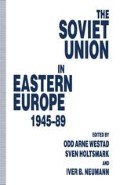Abstract
One of the most striking features of the system that the Soviet Union imposed on Central and Eastern Europe in the aftermath of the Second World War was the sameness of the political organization of their respective societies. In order to make the East European countries a parallel part of his empire Stalin imposed the same standardized patterns in politics, in the army and in the security forces.1 Dana A. Schmidt in her analysis of The Anatomy of a Satellite, written in 1952, pointed out four main spheres of direct imitation:
Immediately upon seizing power in a country, the Communists do four things. They abolish all opposing political parties and establish a oneparty dictatorship; they create secret police; they establish a ministry of propaganda to tell people what they should know and how should they think; and, finally, they surround the whole system with an Iron Curtain. It is moot to ask what comes first. They are interdependent; take one away and the entire structure is threatened. They are four walls of the Communist house.2
Access this chapter
Tax calculation will be finalised at checkout
Purchases are for personal use only
Preview
Unable to display preview. Download preview PDF.
Notes
Flora Lewis, A Case History of Hope: The Story of Poland’s Peaceful Revolutions (New York: Doubleday, 1958) p. 29.
Dana A. Schmidt, The Anatomy of a Satellite (Boston, Little Brown, 1952) p. 17.
J.F. Brown, Surge to Freedom. The End of Communist Rule in Eastern Europe (Durham: Duke University Press, 1991) p. 7.
The description of Hugh Seton-Watson’s classification borrows from Jacques Rupnik, The Other Europe (London: Weidenfeld & Nicolson, 1989) pp. 73–4.
Edgar Morin, O naturze Zwiazku Radzieckiego (De la Nature de l’U.R.S.S., Polish translation, Warszawa: Volumen, 1990) p. 43.
Zbigniew Brzezinski, ‘Foreword’ to Madleine Albright, Poland. The Role of the Press in Political Change (Washington, DC: Washington Papers, 1983) p. v.
In an article ‘What Is To Be Done,’ written in 1902 as a plan for Communist revolution. V.I. Lenin, Collected Works, vol. 1 (Moscow: Progress Publishers, 1967) p. 233.
Mark Hopkins, Mass Media in the Soviet Union (New York: Pegasus, 1970).
Moshe Lewin, The Gorbachev Phenomenon. A Historical Interpretation (London: Hutchinson Radius, 1988).
W. Bruce Lincoln, Nicholas I. Emperor and Autocrat of All Russians (Polish translation, Warszawa: PIW, 1988); and W. Bruce Lincoln, In the Vanguard of Reform (DeKalb, Illinois: North Illinois University Press, 1983).
Natalie Gross, ‘Glasnost’: Roots and Practice’, Problems of Communism, XXXVI (1987) Nov–Dec, pp. 69–70.
Mikhail Gorbachev, Perestroyka. New Thinking for Our Country and the World (New York: Harper & Row, 1987) p. 9.
Zhores Medvedev, Gorbachev (New York, NY: Norten, 1986) p. 209.
Mikhail Gorbachev, Reorganization of the Party’s Personnel policy, (Moscow: Politizdat, 1987) p. 39.
For more details, see Pål Kolstø, An Appeal to the People. Glasnost — Aims and Means (Oslo: Institute for Defence Studies, 1988).
Andranik Migranyan, ‘An epitaph to the Brezhnev doctrine …’, Moscow News (1989) no. 34; see also Sven G. Holtsmark, The Demise of the Brezhnev Doctrine (Oslo, Institute for Defence Studies, 1990).
See for instance Hannes Adomeit, ‘Gorbachev and German Unification’, Problems of Communism, XXXIX (1990) Jul.–Aug., pp. 11ff.
Vladimir Tismaneanu: Eastern Europe After Communism: Reinventing Politics (Glencoe, IL: The Free Press, 1992) p. 239.
Z.A.B. Zeman, Making and Breaking of Communist Europe (London: Blackwell, 1991) p. 311.
Editor information
Editors and Affiliations
Copyright information
© 1994 Palgrave Macmillan, a division of Macmillan Publishers Limited
About this chapter
Cite this chapter
Goban-Klas, T., Kolstø, P. (1994). East European Mass Media: The Soviet Role. In: Westad, O.A., Holtsmark, S., Neumann, I.B. (eds) The Soviet Union in Eastern Europe, 1945–89. Palgrave Macmillan, London. https://doi.org/10.1007/978-1-349-23234-5_7
Download citation
DOI: https://doi.org/10.1007/978-1-349-23234-5_7
Publisher Name: Palgrave Macmillan, London
Print ISBN: 978-1-349-23236-9
Online ISBN: 978-1-349-23234-5
eBook Packages: Palgrave Political & Intern. Studies CollectionPolitical Science and International Studies (R0)

